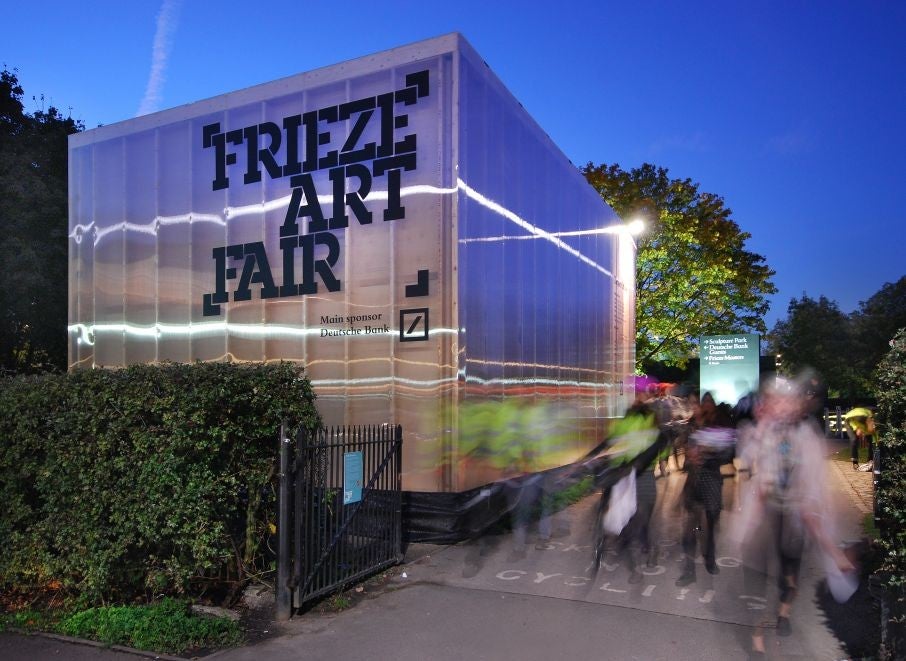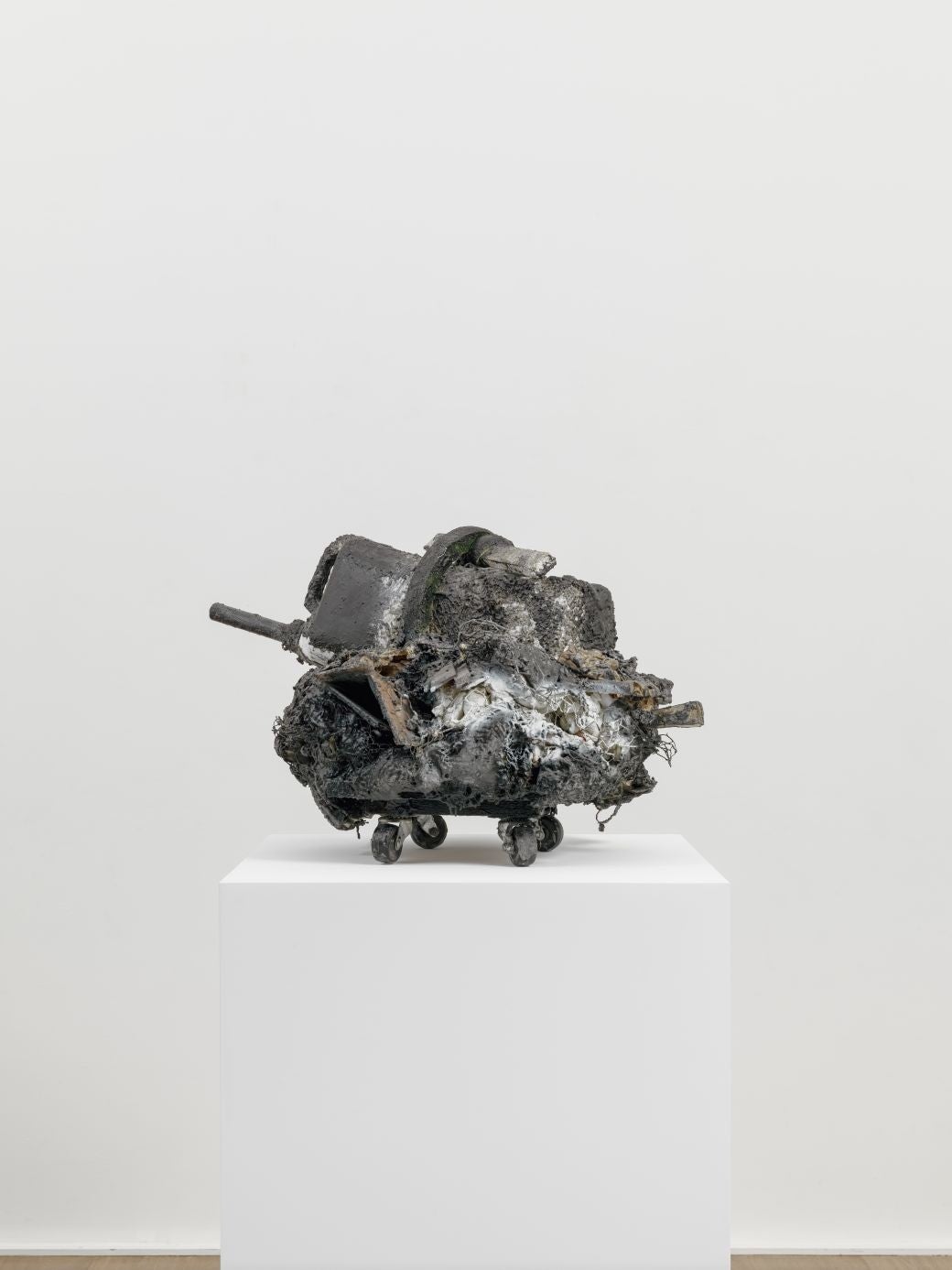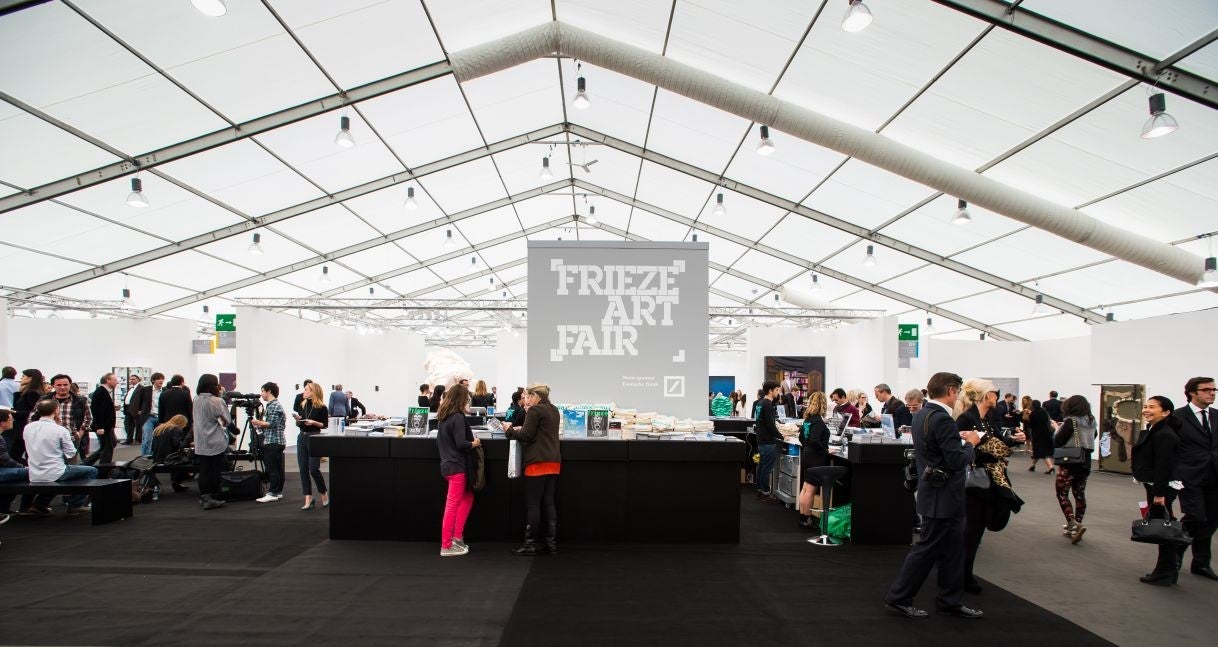Frieze Art Fair 2015: There's a better chance of bagging a bargain this year
Britain’s biggest and blingiest art fair begins next week, with original unique works by younger artists starting under £1,000. These are the artists to look out for and the events to be seen at.

Your support helps us to tell the story
From reproductive rights to climate change to Big Tech, The Independent is on the ground when the story is developing. Whether it's investigating the financials of Elon Musk's pro-Trump PAC or producing our latest documentary, 'The A Word', which shines a light on the American women fighting for reproductive rights, we know how important it is to parse out the facts from the messaging.
At such a critical moment in US history, we need reporters on the ground. Your donation allows us to keep sending journalists to speak to both sides of the story.
The Independent is trusted by Americans across the entire political spectrum. And unlike many other quality news outlets, we choose not to lock Americans out of our reporting and analysis with paywalls. We believe quality journalism should be available to everyone, paid for by those who can afford it.
Your support makes all the difference.The cliché around Frieze Art Fair is glitz: trophy art collectors with budgets the size of a luxury yacht swoop down on the capital to attend opening parties sponsored by Gucci. It’s a voyeur’s glimpse into a gilded dream life where one might buy a photograph by Jeff Wall, which is on show with a price tag of £1m, or there’s a Wolfgang Tillmans for just over £50,000. A sculpture titled recklessdisasters(1) by Phyllida Barlow is £25,000 from Hauser & Wirth.
For five days the international art world is squashed into a giant tent in Regent’s Park. Like in the television series The Great British Bake-Off, the showstopper is an important part of Frieze. More subtle artworks can disappear in the mass of aisles and booths, which welcomes an audience of 60,000, from the most influential collectors and curators to curious tourists and art enthusiasts. For gallerists, curators and artists, the pressure is on to shine.
Lisson Gallery has imported a sculpture titled Iron Root by Chinese artist Ai Weiwei. It’s a tree root from southern China cast in iron and then painted with custom colours used for the Chinese market by car manufacturers –this sculpture is purple. The price is a secret but Ai set a record earlier this year with a series of gold- plated animal heads that went for £2.8m.
“There’s a lot of noise around Frieze so we try to do something that excites us, that excites the artists and hope that this then translates to the audience,” says Iwan Wirth, of London gallery Hauser & Wirth. “We try to do it in a way that we enjoy and that artists enjoy and it’s not just bringing stuff to a fair, or work by some hot young artist. You’ve got to be smart and make your booth work for a fair where the attention span is so small. We try to make a difference, raise the bar a bit.”
Hauser & Wirth has organised an exhibition based on the theme of a field for their booth at Frieze London this year. With sculpture by Isa Genzken (around £22,000) and Jason Rhoades (around £100,000) among others, the idea is that the booth becomes a field of carefully selected sculptures, all on pedestals, in which visitors can get lost for a while – rather like the experience of Frieze itself.
“We try to approach it with humour,” says Wirth, “because when you think about it, it’s funny that the fair happens to be in field in the middle of town and we all come to camp out in it. Quite often it’s the worst weather, and the service is lousy.”
This year as part of Frieze Projects there’s a chamber beneath the main tent, which contains a room designed by artist Jeremy Herbert, who as a set designer built stages for Madonna. It’s art as experience rather than object, and Herbert is the pioneer of a silent wind machine. Visitors will be buffeted by soundless gusts, like being hit by the Invisible Man.
Frieze Masters, now in its third year, is usually a cut above, a place where serious money changes hands, and museums scout out important artworks. This year there’s an emphasis on collecting and not just conventional artworks. Sir Norman Rosenthal has curated a section titled Collections in which fascinating oddities such as collection of 19th-century Pacific fish hooks made of shell and turtle shell are on show.

There will be an elegant display where Moretti Fine Art and Hauser & Wirth have joined booths to show work by recent greats along with old masters. There’s sculpture by French artist Louise Bourgeois and paintings by Austrian artist Hermann Nitsch whose radical artworks echo the human body with orifices and blood-red drips – his prices at auction have varied from £8,000 to £50,000, which is cheap for such a seminal artist. There’s an opportunity to buy an 18th-century painting by Bernardo Bellotto, which belonged to the Earl of Carlisle at Castle Howard before it was sold for just over £2.5m in auction earlier this year. Top-end sales in both old master and contemporary art grab attention but they are more rare than it might seem.
“It’s a few very hot artists who are expensive,” says Wirth, “and that has always been the case. The primary market is not expensive, and original unique works by younger artists start under £1,000. My advice is unless you can afford it be a contrarian and look in the other direction where you’ll find plenty of great artists that are reasonable.”
For smaller galleries, Frieze is their most important date of the year. Hannah Robinson, director of Mary Mary, points out that there’s no real art market in Glasgow, where her gallery is based. Frieze is a chance to introduce new artists to an international market as well as meet collectors and curators. “It’s not only about sales,” she says, “but touching base with clients or meeting new clients.” For those who can’t make the trek to Glasgow, it’s a chance to see work by less well-known talents such as painters Jonathan Gardner and Helen Johnson, as well as elegant drawings by LA-based Milano Chow. Robinson also shows Jesse Wine, a British artist who works with ceramics. His smaller sculptures of vessel-shaped objects that spew tomato vines are priced at £7,000.
For Wine, Frieze is a chance to get his work seen by a huge audience. His sculpture Let Me Entertain You is a tall thin ceramic tower of shapes based on dried citrus fruit – “with the occasional apple”, as the artist points out. It’ll be on show in the Frieze Sculpture Park, curated by the Yorkshire Sculpture Park’s Clare Lilley, and his smaller ceramics will also be in Limoncello gallery. Wine says: “The tough side is that it is about sales. If it goes well you’re really happy because you’re getting paid and you need to get paid in order to continue your projects. If it doesn’t go well then it’s weird, it’s quite confusing, and then you begin to wonder why the hell you’re there.”
“Artists can be ambivalent about art fairs,” says London gallerist Maureen Paley, “but if you trust your gallery you know they will make every effort to give the work more space to breath. That’s the challenge.”
This year Paley will show artists Rebecca Warren, Liam Gillick, Anne Hardy, Gillian Wearing and Wolfgang Tillmans in her booth. In a new photograph, titled Me As Ghost, Wearing has projected her portrait on to a puff of smoke.
For most commercial galleries, the best outcome is for work at Frieze to be bought by a museum or foundation .“It’s always exciting,” says Paley, “because it means that work will be taken into the public domain, which makes it available to a broader group of people. However, all collectors and their varied interests make a strong contribution.”
More modest collections might begin with a limited-edition print from Allied Editions – a print of an elegant architectural drawing by Pablo Bronstein is available for £350, or another, by painter Matt Connors, is £1,000.
The signs for Frieze 2015 point to a strong year for sales. Wirth says: “There is some concern as to the effect from China and the slowdown of the emerging economies but the contemporary market is very healthy, very robust and people are very optimistic.’
However, for most people Frieze is simply an opportunity to look at art and have a good time: “You get to see a lot of stuff very quickly,” says artist Ryan Gander, “and get a really good overview of what people are up to, not in terms of their wider practice and big projects but of what they’re interested in and what’s happening in their studio. Most artists are critical of art fairs because it seems overly commercial but it’s a good chance to meet your friends from all around the world. It’s like a school reunion.”
Frieze Art Fair, London NW1 (friezelondon.com) 14 to 17 October

Five artists to look out for:
Jonathan Gardner
Chicago-based Jonathan Gardner’s paintings draw from the era of bygone greats (Picasso, Matisse and Léger) to create scenes of languid and long-limbed girls with geometric breasts. (At Mary Mary)
Jesse Wine
Jesse Wine’s ceramic sculpture follows no logic: red gilets and shorts suspended in the air above ceramic footwear; odd-shaped bulbous forms with surfaces like moss or rust; a tower of giant citrus fruit. Witty and joyful, they embody craft as much as concept. (At Limoncello)
Carmen Herrera
She celebrated her 100th birthday this year, and Cuban abstract painter Carmen Herrera remains on top form. The Lisson Gallery booth in Frieze Masters is dedicated to her colourful geometric forms. (At Lisson)
Melvin Edwards
A pioneer among artists who engaged with race and the civil-rights movement, Melvin Edwards works with welded steel, chains and barbed wire. Abstract sculpture like cool clean minimalism from the Sixties. (At Stephen Friedman)
Samara Scott Samara Scott’s installation for The Sunday Painter resembles a pond with a bedazzled surface beneath the water. Titled ‘Lonely Planet’, it contains a mass of materials: noodles, tights, wine, nail varnish, food colouring, insulation foam. A shimmered surface becomes a meditation on consumption and waste. (At The Sunday Painter)
Parties to be seen at:
Institute of Contemporary Arts
The ICA hosts the first official Frieze bar during Frieze week.
Institute of Contemporary Arts, The Mall, London SW1
East End Night/ West End Night
On Wednesday evening, East End Night means galleries stay open until 8pm. On Thursday, West End Night, repeats the same idea in the West End.
Royal Academy
On Thursday, the Royal Academy hosts the private view for Ai Weiwei’s exhibition.
Royal Academy, Burlington Gardens, London W1
Delfina Foundation
Delfina Foundation’s opening party happens the Friday before Frieze.
Delfina Foundation, Catherine Place, London, SW1
Maureen Paley gallery
An opening party on Monday of Frieze week celebrates a new body of work by Liam Gillick, the star of Joanna Hogg’s film ‘Exhibition’.
Maureen Paley, Herald Street, London E2
Join our commenting forum
Join thought-provoking conversations, follow other Independent readers and see their replies
Comments